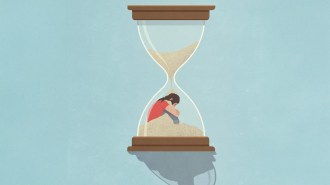Joint attention provides clues to autism and cooperation
Psychologists and philosophers convene to discuss the roots of shared knowledge at a meeting in Waltham, Mass.
Psychologists and philosophers convene to discuss the roots of shared knowledge at a meeting in Waltham, Mass.
Different paths to childhood autism
Being born into a world of darkness provides an unappreciated avenue to autism, researchers suggested October 2.
Within the first few months of life, babies display a basic form of what researchers call joint attention. An infant will maintain a steady gaze with a nearby adult and imitate that adult’s simple actions, such as sticking out the tongue. By age 2, joint attention becomes more complex. Two children, for example, can convey with just a look that they both know that one toy is better than another.
Many scientists view joint attention as a skill essential to forming relationships with others and communicating effectively. Early difficulties with joint attention because of blindness from birth can block emotional contact with others and foster autism, said psychologists Peter and Jessica Hobson of University College London.
Autism related to congenital blindness stems from an inability to see anyone or anything, making it exceedingly difficult for a child to achieve joint attention and develop social skills, Peter Hobson suggested. Among these children, though, symptoms tend to diminish by adolescence.
At several British schools for the blind, the researchers assessed 24 congenitally blind children, half age 3 and half age 9. Symptoms of autism, such as a lack of social and communication skills, appeared in all of these children. Half qualified as having autism.
Compared with nine sighted kids with autism, also ages 3 or 9, nine low-functioning blind children with the developmental disorder showed slightly more engagement with others in social settings. Eight years later, all nine sighted children remained autistic, compared with only one blind child.
Instigating cooperation with a look
A little look elicits a lot of cooperation from preschoolers. Pairs of 4½-year-olds work together more often to obtain a mutually valued prize when an adult experimenter not only looks at the prize but also makes eye contact with the kids, psychologist Emily Wyman of the Max Planck Institute for Evolutionary Anthropology in Leipzig, Germany, reported October 2.
“Joint attention with an adult provided a framework for these children to cooperate,” Wyman said.
Wyman developed a game in which pairs of children crouched at one end of a table, separated from each other by a wooden partition. Wyman stood at the other end of the table, in front of three chutes that ran to the children. Each chute contained a hole in its floor, located just in front of the youngsters.
Wyman repeatedly displayed small packs of blue stickers and delivered them to children via the outer chutes. Each child was given a block to place over an outer chute’s hole so stickers wouldn’t fall through. On occasion, Wyman held up blue stickers and another prize of higher value — pingpong balls and colored stickers to put on the balls. She put the high-value prize in the middle chute, which contained a large hole that could only be covered if both children put their blocks over it.
So, children had to cooperate to get the better prize. A child who put a block in the middle chute without the other’s contribution ended up with nothing.
When Wyman kept her head down and looked only at prizes before putting them in the chutes, 11 of 23 children in one experiment cooperated to get the high-value prize. When she looked at prizes and then made brief eye contact with players when she was holding a high-value prize, 19 of 23 children in a second experiment worked together to nab the better prize.
Wyman suspects that the eye contact heightened players’ attention to the availability of the high-value prize.
Gaze tracking gets a hand
Babies learn to follow a parent’s gaze by first watching hand movements, psychologist Gedeon Deák of the University of California, San Diego proposed October 3.
“Infants rarely track adults’ eye gaze in a cluttered, natural environment, but they can learn to track gaze by watching adults handle objects,” Deák said. He and his colleagues found that babies like to watch what adults do with their hands. Eventually babies notice head poses and eye directions associated with adults’ hand actions, he hypothesizes.
Babies don’t coordinate attention with caregivers via shared eye gaze until perhaps 12 to 18 months of age, in Deák’s view.
His team analyzed videos of 35 infants, ages 3 to 11 months, playing with their mothers at home. Behaviors were examined frame-by-frame during 5- to 7-minute play sessions.
Infants displayed almost no gaze tracking, though mothers frequently looked directly at them. Mothers’ spoken comments, pointing, tapping, picking up of items and rattling of toys seldom elicited eye gazes from babies. Youngsters typically first looked toward their mothers and then quickly fixated on toys and other objects in their mothers’ hands.
While manipulating objects, mothers often watched their own hands as well. Earlier research has found that adults generally look at their own hands while performing actions on objects. Infants may use this systematic pattern of behavior to discern a connection between what adults do and where they’re looking, Deák proposes. Only then do a mother’s eyes become a window to the social world.
Deák and his colleagues have used their behavioral data to design three-dimensional, virtual caregivers and infants on a computer that play together in realistic settings. Using biologically inspired learning rules, virtual infants rapidly go from observing virtual caregivers’ object manipulations to tracking their eye movements. The team plans to do more complex studies with the virtual people and long-term studies with actual babies.







